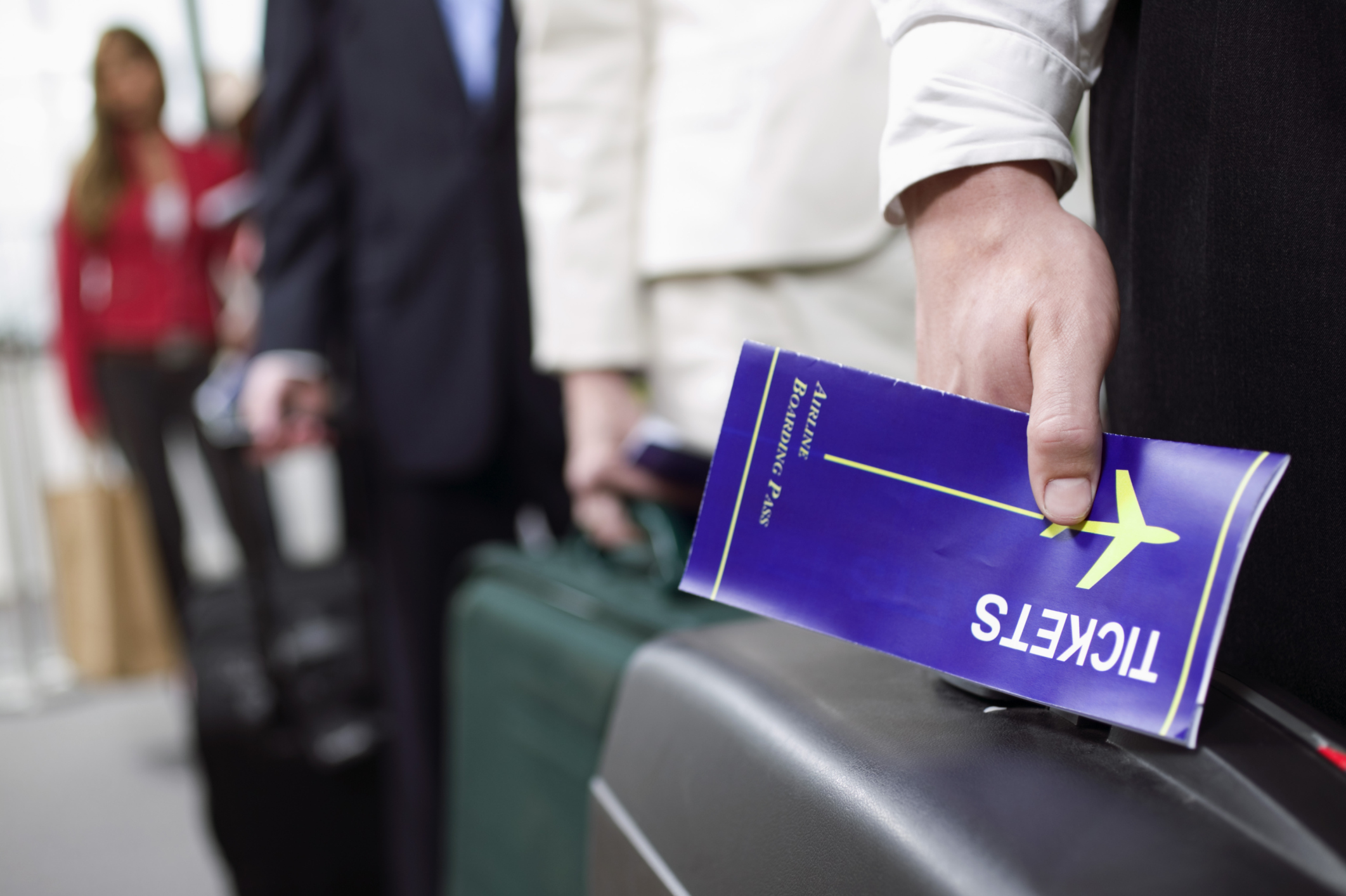Want to win $250 in cash? (Who wouldn't?) You just need to share this post. Click here for more info.
Travelling — something we can look forward to and enjoy, but also get tremendously annoyed about, depending on what happens before, during or after we get on and off the airplane.
Thankfully, most of these things can be avoided with proper planning, street smarts and some kiasu behaviour thrown in — those beyond our control, though, we’ll just have to suck thumb and hope our insurance covers it.
We take you through some of these, as well as share tips on how to prevent or tackle them:
Before boarding:
1.
 Photo from Thinkstock, created on imgflip
Photo from Thinkstock, created on imgflip
This would be less horrible if it were your departing flight, but still horrible — all your plans and bookings will go to naught, especially if the next one isn’t going out for a day or more.
How to fix it: Get yourself on the next flight going out — and make sure the airline gets you on it for free. Do what you have to: make noise, kick up a fuss. You should expect no less, particularly if you are on a full-service carrier.
2.
 Photo from Thinkstock, created on imgflip
Photo from Thinkstock, created on imgflip
This is horrible, because it usually comes after multiple other delays in the hours that preceded this, ending with “the crew have exceeded their permissible work hours” — by which time you and your fellow passengers are probably prepared to strangle somebody in order for some proper answers and the ability to board a plane that will take off ASAP.
How to fix it: Thank your lucky stars if you happen to be in your home country, because at least you can go home to rest. Otherwise, demand (always nicely at first) a nice hotel room and free transport back and forth — and don’t forget to keep your plane tickets and take note of the number of hours the flight has been delayed so you can file for insurance claims.
Also, in order to add full insult to (their) injury, be sure to get a written confirmation of this from the airline as evidence against them.
3.
 Photo from Thinkstock, created on imgflip
Photo from Thinkstock, created on imgflip
This gets worse the more expensive your liquids happen to be. Your specialist brand curling hair mousse spray you cannot do without? You’ll just have to go without it, and buy another when you’re back home again.
How to fix it: If you REALLY must keep whatever it was you forgot to check in, you could dash over to the nearest convenience store (in the ticketed departure area) and purchase small empty bottles to pour/spray your liquids/aerosols into.
If you’ve got shaving cream or anything else that would dissolve or turn into a form you can’t use, that’s just too bad. Alternatively, you could pay about $10 to mail it to yourself (no guarantees on how soon it’ll return, though — given how reliable SingPost is, you might as well buy yourself a new can or bottle of whatever it is.) Check your carry-on bag super-carefully before checking in your check-in!
4.
 Photo from Thinkstock, created on imgflip
Photo from Thinkstock, created on imgflip
Very often, this is a so-near-yet-so-far situation. Happens less commonly in Singapore than elsewhere, but it’s no less shitty when it does occur, no matter which country you’re in.
How to avoid it: If you’re headed for a homeward flight and you’re travelling a long distance to the airport, budget an extra hour or two (depending on the length of your journey — speak to the local driver taking you there for his advice) to make sure you’re there with enough time to check in and clear immigration and customs.
There is a saving grace if this has already happened to you — if the jam was caused by crazy weather (e.g. hurricane, typhoon) or by a riot, keep in mind the number of hours you held your bladder in the backseat.
That way, you can file for claims when you (finally) reach home.
On the plane:
5.
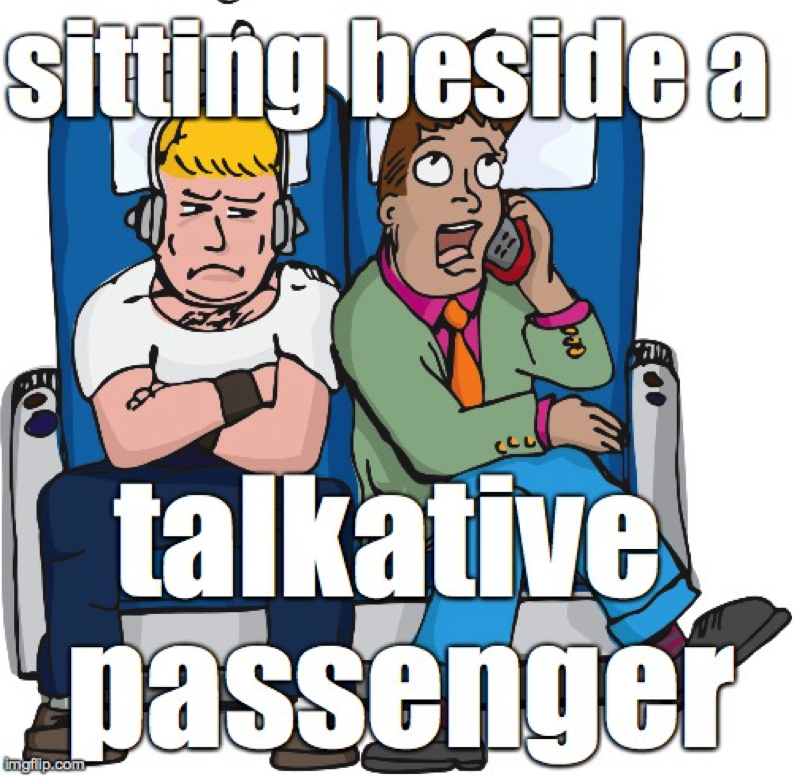 Photo from Thinkstock, created on imgflip
Photo from Thinkstock, created on imgflip
Yes, a person who just won’t shut up is EXACTLY what you need for a 12-hour red-eye flight. Because obviously, you booked that timing so you could SPEND ALL OF IT HEARING ABOUT THEIR TRAVEL JOURNEY HERE AND HOW EXCITED THEY ARE.
 Source: Giphy
Source: Giphy
How to fix it: Tell the person, as nicely as you can, that you’re really tired and would like to get some sleep. Keep an eye mask with you (or if you’re on a full service carrier, request one!) and put it on the moment you find a lull in the conversation — that’s a pretty strong signal if there was any — and if all this doesn’t work, ask the cabin crew if they can move you somewhere quieter. And pray you’re not on a full flight.
This will also solve your problems if you also happen to be near a screaming baby or toddler.
6.
 Photo from Thinkstock, created on imgflip
Photo from Thinkstock, created on imgflip
Great, just great — because it’s not as if Economy Class doesn’t already cramp you into complete discomfort to begin with.
How to fix it: You’ve gotta use the pleasant way to begin with — no getting round that. If you’re not the “confrontational” sort, you can adopt the passive-aggressive approach: slowly use your arm to inch your way onto the armrest between your seats, and keep it there until the annoying person gets the message and shifts away.
Although this gets way more challenging when the person beside you happens to be a mobile sleeper — if you know what we mean.
After you land:
7.
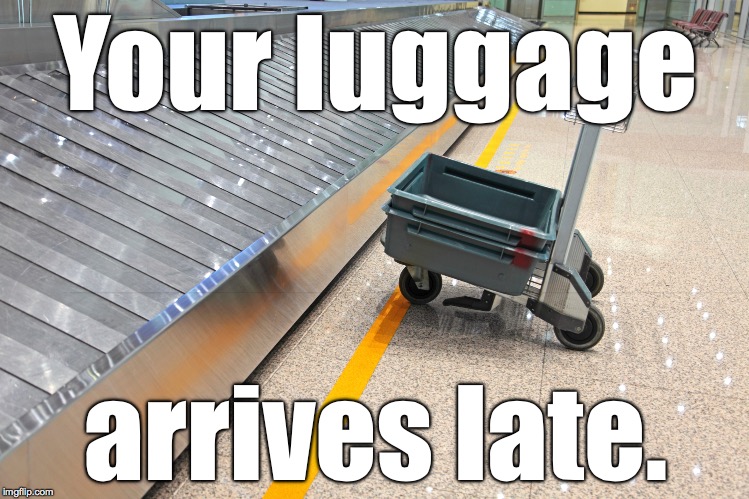 Photo from Thinkstock, created on imgflip
Photo from Thinkstock, created on imgflip
Few things worse than reaching your dream destination… to realise you haven’t got any clothes to wear there for the first few days — if not, up to a week. Worse still if you travelled, for instance, from Singapore to, say, Iceland.
How to fix it: Not a whole lot you can do after this happens, unfortunately, except to continuously bug the airline until it arrives. But be sure to retain your boarding pass and obtain documentation from them that confirms your stuff arrived late — and caused you immense pain (and cold, in the instance of Iceland). Also, if you bought stuff to tide you the period till it does arrive, you can probably demand compensation for them, so keep your receipts — and take this chance to buy yourself some Chanel underwear (essentials mah) while you’re at it.
8.
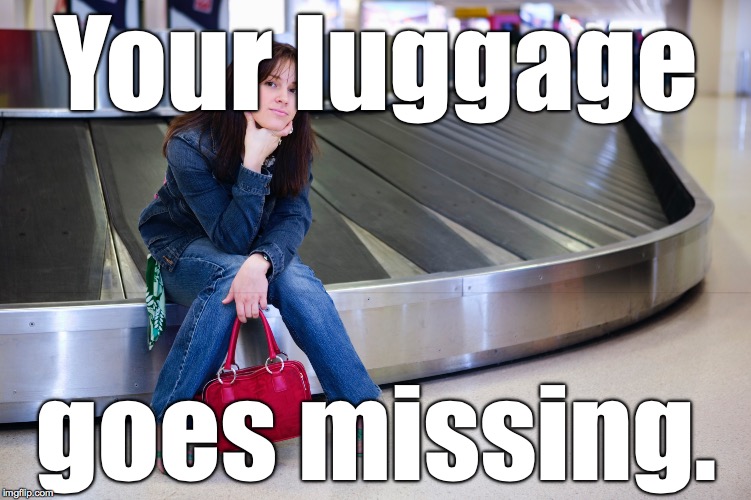 Photo from Thinkstock, created on imgflip
Photo from Thinkstock, created on imgflip
This one jipai siao liao la. Not much we can add about this — or that we need to, anyway.
How to avoid it: The only way, well, is if you only took carry-on — although that isn’t practical for a long trip — and the only things you can do in this scenario are to a) file a notice of missing baggage with the airline and b) slowly take stock of what was in there and work on valuing it for insurance claims.
9.
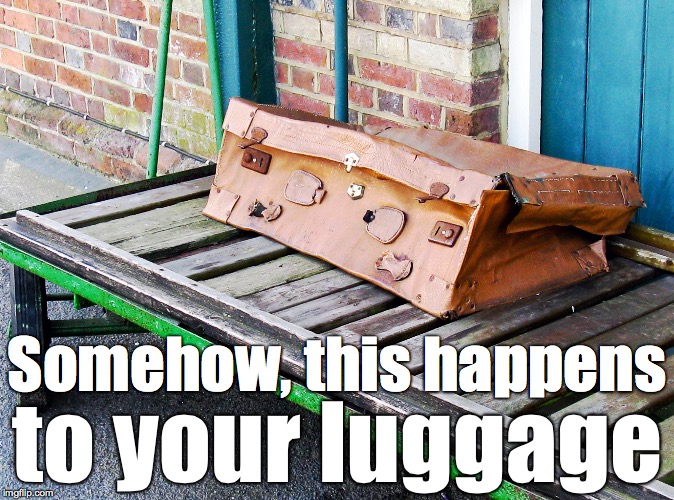 Photo from Thinkstock, created on imgflip
Photo from Thinkstock, created on imgflip
Ditto above, except we might add that this actually is almost entirely avoidable.
How to avoid it: Pack your stuff in a hard case, if you plan to check in your items. If you’ve got fragile or breakable items, please la, just carry it on board so you can look after it. You can be sure that no matter how many “FRAGILE” stickers you put on your item, air transfer crew will read them as “Please throw my luggage around AS HIGH AS YOU CAN IN THE AIR, and AS HARD AS YOU CAN ONTO THE GROUND.”
If it’s something too heavy, like a cello, for instance, check it in at your own risk — depending on how much sentimental value you place on it, you can either fork out money to cover its insurance or for a second plane seat for it.
10.
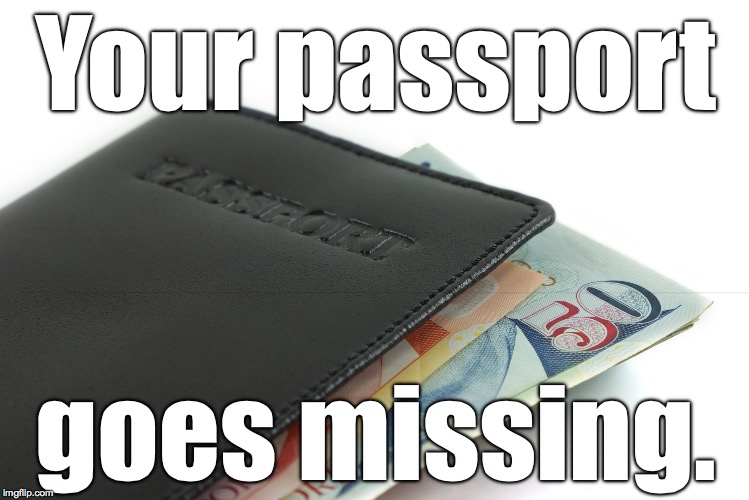 Photo from Thinkstock, created on imgflip
Photo from Thinkstock, created on imgflip
This ranks pretty high on the levels of sian, whether you misplaced it or it got stolen, but hopefully in the event this should happen to you overseas, you’re near enough to a Singapore embassy to report it.
How to avoid it: Carry it close to you, within sight, at all times. You should do this with all valuables, really — and a regular traveller would certainly know this too well. Also, have a photocopy of your passport ID page (the hard one with the chip) with you, and for good measure, make another copy to give to a travelling companion, if you’ve got one. That will see you to the gate for your trip back home, at least.
11.
 Photo from Thinkstock, created on imgflip
Photo from Thinkstock, created on imgflip
In some places, you just have to deal because you should understand that not everywhere, even if it looks nicer than Singapore’s pristine malls, will have a nice, clean and free public toilet for you to use at the moment you gotta go. And when you gotta go, you gotta go.
How to deal: Depending on where you’re going, you may want to consider packing a roll of toilet paper and/or packets of tissue that you can use if the toilet you visit happens to lack these facilities. Or if the person before you happened to, erm, not have good aim (and believe us, this inexplicably happens with women too).
12.
 Photo from Thinkstock, created on imgflip
Photo from Thinkstock, created on imgflip
This boils down to research and pre-trip preparation. If you’re in this situation, and the locals really cannot understand or speak English or any of the other languages you can whip up, chances are the local signs aren’t gonna be of much help to you either.
 Source: Wikimedia Commons
Source: Wikimedia Commons
Coupled with this problem is not knowing which language to use to speak to people, simply because you can’t tell a French-speaking Swiss from the German, or the Indian from the Sri Lankan.
How to avoid/fix it: To avoid it, check beforehand what the local language is, as well as whether people know or speak English. If they don’t, it’s worth downloading a language app or two to learn basic words and phrases in the local language to help you get by and around.
In the case of not being sure what language to speak, try to hear them speak and then identify the language before going up to them. Most locals who are pleasant enough will understand that you’re a tourist and may sometimes get things wrong, so the best way to go about this is to be polite — a polite person making a mistake or a cultural faux pas is always, always infinitely better than a rude person doing anything. Even if they should get the language right.
If you weren’t prepared for it and are already there — sign language, perhaps? You can be assured that any charades skills you can muster will come in handy.
13.
 Photo from Thinkstock, created on imgflip
Photo from Thinkstock, created on imgflip
This, depending on the extent of damage, is going to be no fun for you at all — especially your wallet, and especially if you’re the only one in your group of travellers with an international driver’s license. Or worse, the only one with a driver’s license that hasn’t been converted to an international one.
How to fix it: Not much, by our reckoning, except to cough up the excess repair money and keep all the receipts for claims (although know that not all travel insurance policies cover this) — if it wasn’t your fault, pray someone nearby who stopped to help you when the accident happened saw or had in-vehicle cameras to record it. Be prepared for a long, uphill legal climb though, which may not be worth your while.
14.
 Photo from Thinkstock, created on imgflip
Photo from Thinkstock, created on imgflip
There’s nothing like a good ole robbery/snatch theft to make you depressed about a holiday, eh? Sometimes, no matter how close you carry your stuff to your chest, this does happen — either because you were suay and the robber didn’t like your face, or you looked like you had a lot of money on you.
How to fix it: You could try reporting it to the police, but from our anecdotal experience we almost never hear of people who manage to get their stuff back that way — although at least you’ll have a copy of your police report, which you can use for claims later on. Also for this purpose, keep track of your expenses and of how much cash you have.
How to avoid it: Don’t show your money, as far as possible. Handle your cash discreetly, and also place it in different places — don’t put it all together. Also don’t hold your phone in your hand, especially if it’s, say, the iPhone 6s Plus. In fact, don’t even bring it on your trip: swap your SIM card out to a cheap phone, like a Redmi. It’ll still take the nice pictures you want, and you won’t feel as much pain if it gets stolen or goes missing.
15.
 Photo from Thinkstock, created on imgflip
Photo from Thinkstock, created on imgflip
All we can say about this is “ugh”.
How to avoid it: Perhaps we should say, “How to avoid punching people who do this”. Since a person who does this is usually a shopkeeper trying to attract your business (but in, of course, the worst way possible), or a person whose next move will be to ask you for money, just ignore them, take a deep breath and hold your peace. And move quickly away from the source of the disturbance.
16.
 Photo from Thinkstock, created on imgflip
Photo from Thinkstock, created on imgflip
This, well, we’d see as a happy problem. Especially in places like Thailand, where locals get free admission to tourist attractions.
How to fix it: Smile, and where it’s advantageous to you, pray your grasp of the local language will help you pull off the act as long as you need to. Or if the local starts speaking to you extensively in the language, at skill levels you know you’ll never master, it would be a good idea to politely tell him/her you’re from abroad, as early on as possible.
17.
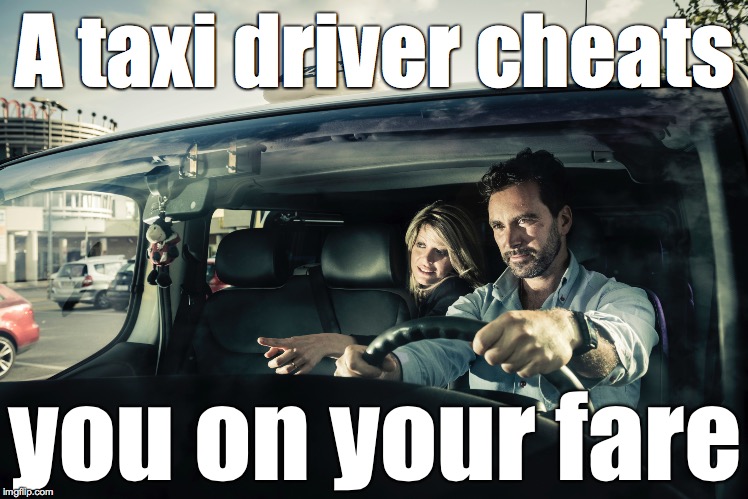 Photo from Thinkstock, created on imgflip
Photo from Thinkstock, created on imgflip
Yep, we’ve all been there before — when what should cost around S$5 turns into a S$26 journey. No one enjoys being cheated, or taken on a proverbial “ride”, and it’s a surefire way to a mood-dampener on your trip.
How to avoid it: Find out earlier from locals you can trust or through reading a reliable guide how much the fare for the distance you’re travelling should be. When boarding a taxi, be sure to agree on going with metred fare — although this sometimes isn’t foolproof, we’ve been in taxis where the drivers fix the metre to jump faster than usual. Where this isn’t available, agree on a fare based on your prior research.
18.
 Photo from Thinkstock, created on imgflip
Photo from Thinkstock, created on imgflip
This is often regrettable — just hope you at least enjoyed the food you ate before the next morning’s assfire.
How to avoid it: Bring your own stash of charcoal pills (for diarrhoea) and water purifying tablets (if you’re in a place without readily-available clean water — a mountain, for instance), and be cautious of tap water. Always drink out of a sealed bottle if you’re not sure, and be responsible and wary of your own dietary restrictions.
And if you end up seeing the doctor because you’re the dying dead and have no relevant meds, remember to keep the receipts before passing out.
19.
 Photo from Thinkstock, created on imgflip
Photo from Thinkstock, created on imgflip
This is a pain all Muslim travellers are likely to understand all too well, especially in, say, Japan or Spain, where you can’t rely on McDonald’s to be halal, and everywhere you look (in Spain) you see jamon.
How to avoid it: Do research beforehand to find out where the halal food places are, or see if there are halal sections in local supermarkets. If there aren’t any, you’ll just have to go vegetarian — or bring your own canned meat?
This last one's a biggie:
20.
 Photo from Thinkstock, created on imgflip
Photo from Thinkstock, created on imgflip
A royal pain (not just literally), because especially if you’re in Europe, the cost of treatment, even at a local clinic, will set you back by a lot. And we mean a lot — how else do you think the country funds its super-affordable healthcare system?
How to fix it: If you need urgent medical attention, please don’t skimp on the money. A good travel insurance policy will cover your hospitalisation and treatment fees — and in some cases, even the helicopter journey needed to airlift you to the nearest hospital (which could be hundreds of kilometres away).
What’s the moral of the story from all this? Beyond being street-smart and making sure you do all your research, preparation, smart packing and such, be sure to get yourself a robust travel insurance policy — especially if you are going diving, hiking or mountain-climbing somewhere remote. It’s always better to protect yourself, because you never know what could happen.
With this handy information (and the right travel insurance!) in mind, you are ready for your much-deserved getaway from Singapore.
Consider the comprehensive protection of TravelEasy insurance by MSIG. It provides up to 51 benefits in 3 Plan options for individual travel, families and groups of up to 20.
Visit www.msig.com.sg to apply and enjoy 35 per cent discount off Single Trip plans. If you are travelling in a group of 6 or more, you'll enjoy a further discount of up to 15 per cent.
Psst: Exciting news from MSIG Insurance NEXT WEEK – check in at www.msig.com.sg for updates!
This advertorial is sponsored by MSIG Insurance (Singapore) Pte Ltd. (“MSIG”) and not a contract of insurance. Full details of the terms, conditions and exclusions of TravelEasy insurance policy can be found at www.msig.com.sg. Promotion terms and conditions apply.
Top photo from Thinkstock.
If you like what you read, follow us on Facebook and Twitter to get the latest updates.
If you like what you read, follow us on Facebook, Instagram, Twitter and Telegram to get the latest updates.
